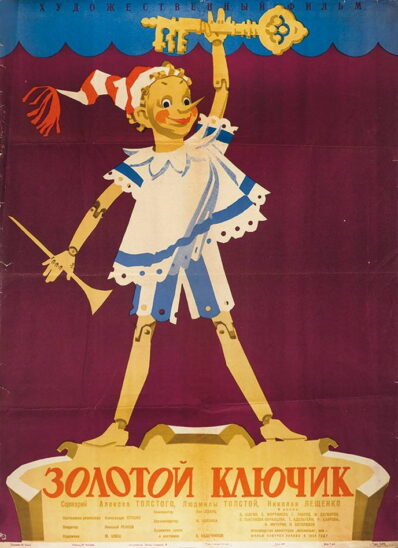With all the newfound interest in Carlo Collodi’s PINOCCHIO (there were no less than two major film versions in 2022), I say it’s a good time to revisit one of its most unique variants: the 1939 Soviet children’s fantasy THE GOLDEN KEY (ZOLOTOY KLYUCHIK) from the incomparable Alexander Ptushko (1900-1973). Ptushko was at an early stage of his career in 1939, and while the film isn’t as striking as later Ptushko works like THE STONE FLOWER/Kamennyy tsvetok (1946) and RUSLAN AND LUDMILA/Ruslan i Lyudmila (1972), it is impressive.
THE GOLDEN KEY’S basis was the 1936 text THE GOLDEN KEY; OR THE ADVENTURES OF BURATINO by Alexey Tolstoy, which was a loose retelling of PINOCCHIO (as international copyright laws weren’t observed in 1930s Soviet Union). That means you likely know at least the some of the story’s particulars: in a fairy tale world a man tries to chop a log, only to discover that it can talk and move on its own (not hard to accept given that all the animals in this world talk). He gives it to his elderly chum Papa Carlo (Georgiy Uvarov), who carves the log into a mouse-sized boy (Olga Shaganova-Obraztsova) with a long nose (which doesn’t grow). He names the wooden boy Buratino.
A non-Collodi imagined addition to the PINOCCHIO-verse is Karabas-Barabas (Aleksandr Shchagin), a sleazy puppet show impresario. Karabas seeks a treasure found behind a “secret door” someplace, accessible by a golden key in his possession. Buratino, on his way to school, decides to check out Karabas’ show–and in so doing gets briefly employed by the latter, leading to a pursuit in a swampland where Buratino is fleeced by a pair of evil rats but gains a sympathetic band of companions that include a talking dog owned by Karabas. Buratino also gets a hold of the golden key, and is pursued by Karabas back to Carlo’s house, where the secret door lies.
This being a black and white film, the bold color scheme that was so integral to Ptushko’s universe is absent. His storytelling skills likewise had a way to go, with the film feeling far too antic and compressed for its own good. Yet other Ptushko trademarks, such as lush visuals and groundbreaking special effects, are very much in evidence.
The special effects alternate stop motion and live action in a manner that was unprecedented in 1939. The mixture is not without hiccups, with the close-ups done live and the wide shots in stop-mo, and often incorporated in highly distracting, and downright bizarre, shots. The pic, in common with most Russian fairy tale films, seems downright psychedelic by modern standards, although its historical value can’t be denied.
Incidentally, THE GOLDEN KEY has been remade several times, most interestingly in 1976 as a Russian TV movie.
Vital Statistics
THE GOLDEN KEY
Mosfilm Studios
Director: Aleksandr Ptushko
Screenplay: Nikolay Leshchenko, Lyudmila Tolstaya
(Based on a by Alexey Tolstoy)
Cinematography: Nikolai Renkov
Editing: Vsevolod Massino
Cast: Aleksandr Shchagin, Sergey Martinson, Olga Shaganova-Obraztsova, Georgiy Uvarov, Nikolay Bogolyubov, Mikhail Dagmarov, Tamara Adelgeym, R. Khairova, Nikolai Michurin

